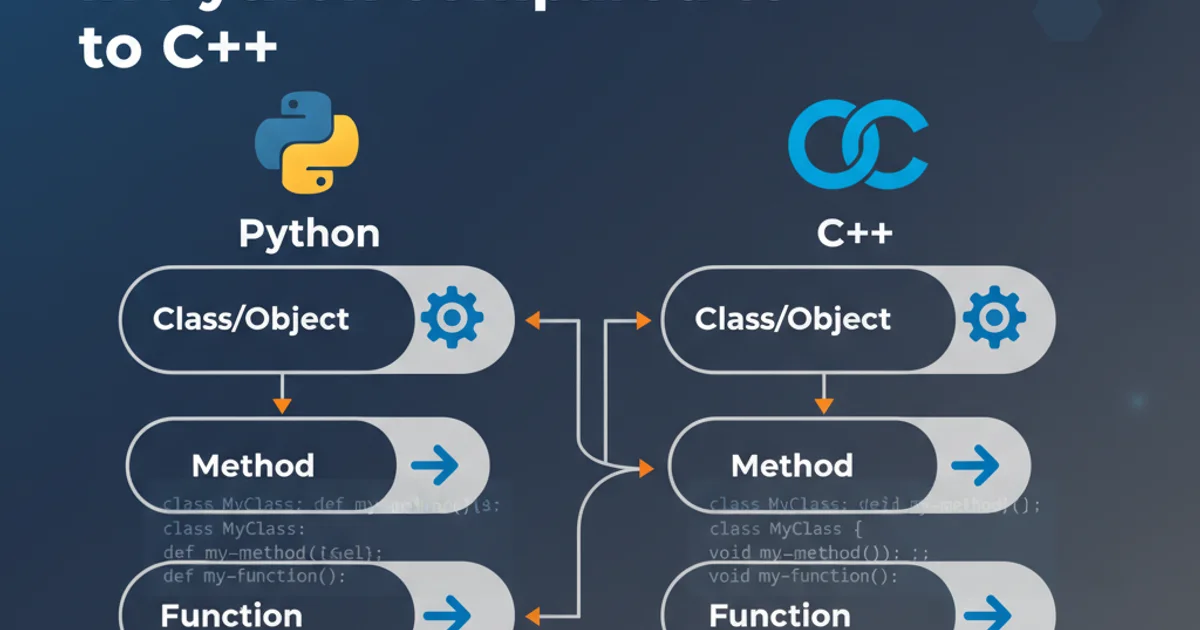Difference between methods and functions, in Python compared to C++
Categories:
Methods vs. Functions: A Python and C++ Perspective

Explore the fundamental differences and similarities between methods and functions in Python and C++, understanding their roles in object-oriented programming and procedural paradigms.
In the world of programming, the terms "method" and "function" are often used interchangeably, leading to confusion, especially for beginners. While both are blocks of code designed to perform a specific task, their context and how they operate within a program can differ significantly, particularly when comparing object-oriented languages like C++ and Python. This article will clarify these distinctions, highlighting how each language treats these constructs and their implications for code organization and execution.
Understanding Functions: The Independent Code Block
A function is a standalone block of code that performs a specific task. It can accept input parameters, process them, and return a result. Functions are independent of any particular object or class. In procedural programming, functions are the primary means of organizing code. Both Python and C++ support functions, though their syntax and typical usage might vary.
def greet(name):
return f"Hello, {name}!"
message = greet("Alice")
print(message)
A simple function in Python.
#include <iostream>
#include <string>
std::string greet(const std::string& name) {
return "Hello, " + name + "!";
}
int main() {
std::string message = greet("Bob");
std::cout << message << std::endl;
return 0;
}
A simple function in C++.
Understanding Methods: Functions within Objects
A method is a function that is associated with an object or a class. It operates on the data (attributes) of that object. Methods are a cornerstone of Object-Oriented Programming (OOP), enabling encapsulation and defining the behavior of objects. When you call a method, you're typically invoking it on an instance of a class, and it implicitly receives a reference to that instance (e.g., self in Python, this in C++).
classDiagram
class PythonClass {
+attribute: str
+method(param: str): str
}
class CppClass {
-attribute: std::string
+method(param: std::string): std::string
}
PythonClass "1" -- "*" CppClass : Comparison
PythonClass : +__init__(attribute)
CppClass : +CppClass(attribute)Class diagram illustrating methods within Python and C++ classes.
class Dog:
def __init__(self, name):
self.name = name
def bark(self):
return f"{self.name} says Woof!"
my_dog = Dog("Buddy")
print(my_dog.bark())
A method (bark) defined within a Python class.
#include <iostream>
#include <string>
class Cat {
public:
std::string name;
Cat(const std::string& catName) : name(catName) {}
std::string meow() {
return name + " says Meow!";
}
};
int main() {
Cat my_cat("Whiskers");
std::cout << my_cat.meow() << std::endl;
return 0;
}
A method (meow) defined within a C++ class.
Key Differences and Similarities
While the core concept remains, the implementation and emphasis differ. In Python, everything is an object, and even functions are first-class objects. This blurs the line slightly, but the distinction based on association with an instance still holds. In C++, the distinction is more explicit due to its strong typing and explicit class definitions.
self) as its first argument, allowing it to access and modify instance attributes. In C++, methods implicitly have access to the this pointer, which points to the current object instance.flowchart TD
A[Code Block] --> B{Associated with an Object/Class?}
B -- Yes --> C[Method]
B -- No --> D[Function]
C --> E[Operates on Object's Data]
D --> F[Operates on Input Parameters]
E & F --> G[Performs a Task]
G --> H[Returns a Result (Optional)]Decision flow for distinguishing between a method and a function.
Practical Implications
Understanding this distinction is crucial for writing clean, maintainable, and object-oriented code. Functions are ideal for utility operations that don't depend on the state of a particular object. Methods are essential for defining the behavior and interactions of objects, promoting encapsulation and modularity. Choosing between a function and a method depends entirely on whether the operation logically belongs to an object or stands alone.
self) but rather on the class itself (cls) or neither. C++ has static member functions which are similar to static methods in Python.